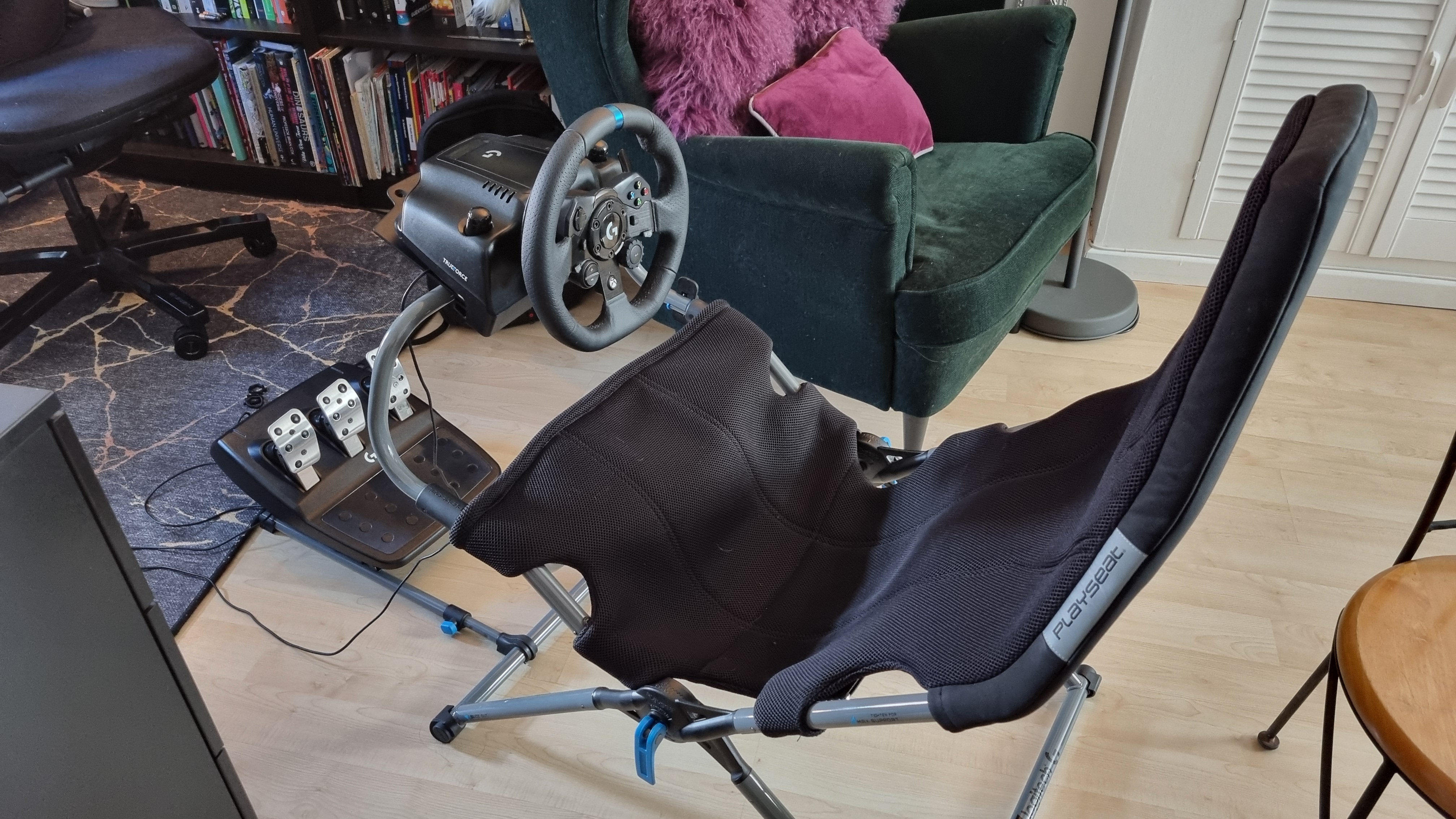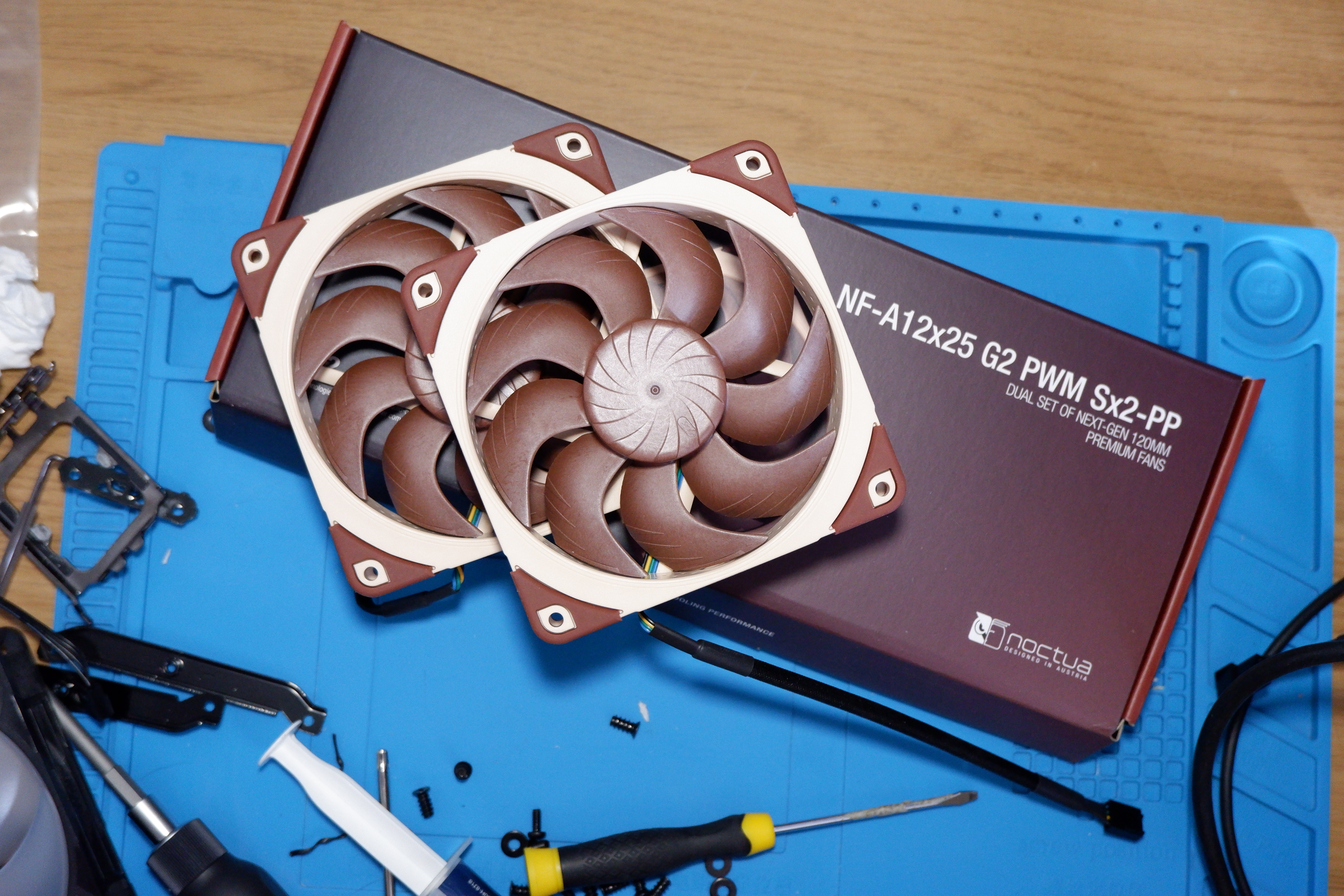
Comfortable and decently sturdy, but the odd durability issue and some similar competition raises a question mark.
As anyone who sim races on a regular desk setup will tell you, compromises must be made. While most of the best racing wheels will come with desk clamps for the wheelbase, what you won’t realise until you use one for yourself is the amount of self-adjustment you’ll need to perform on the regular to keep yourself in an optimum position.
For a start, there’s your desk chair. Chances are it doesn’t lock in terms of spinning movement, which means a decent wheel with good feedback will try and turn you around its axis as you fight against the torque, requiring quite a bit of core stability to maintain a good position. There’s also the angle itself, which, unless you elevate your pedal set or are a particular fan of Euro Truck Simulator, won’t feel very car-like.
And then there’s the pedals, which—despite the best attempts of manufacturers—will still inevitably move around under heavy braking. All in all, it’s a bit of a faff, which is why sim racing enthusiasts tend to buy a heavy sim rig frame to keep you in the optimum position and securely clamp down all your gear. Trouble is, they’re big, heavy, and bulky.
That’s where the Logitech Playseat Challenge X comes in. Playseat has been making gaming chairs and relatively lightweight sim rig setups for a while, and now, in collaboration with Logitech, has come up with something that not only aims to keep your sim racing gear pinned in the right positions, but can be folded away for easy storage too.
At $300/£260 it’s a fair bit cheaper than the $599 Playseat Trophy—although still not what anyone would call cheap in general—and while the Trophy is plenty sturdy, it doesn’t fold up the same way the Challenge X does. The idea here is that you can simply pack your sim rig away like an oversized, folding camping chair. On the face of it, that is a whole lot more convenient and sociable than dedicating space to a more permanent setup.
The box itself was a lot more compact than I was expecting, too, which suggested to me that I was in for a heavy afternoon of construction. However, many more parts were pre-assembled than it first appeared, everything was well-machined and clipped together with minimal effort and no real hang ups, and, thanks to some good instructions and a clearly thought out process, I was done building the chair in less than an hour. And that included taking plenty of photos for this review and a mid-construction cup of tea.
(Image credit: Future)
(Image credit: Future)
(Image credit: Future)
(Image credit: Future)
(Image credit: Future)
The seat cover is attached to the chair with velcro straps underneath the frame, which initially gave me some pause. However, the bulk of your weight is supported by a gigantic strap underneath your posterior. Being a bit of a perfectionist when it comes to builds, I initially mis-aligned it and wanted to straighten it up for a photo, and discovered that it’s coated in what might possibly be the strongest Velcro connection known to humankind. Though that did give me some reassurance it would be capable of taking a large amount of weight.
Sitting in my handiwork for the first time was still a bit of a nerve-wracking experience. The Velcro initially crunches as it first adjusts to the pressure, but once in place you do feel remarkably secure. The frame poles are a good thickness, and the design means that the chair resists rocking from side to side perfectly. Grand.
Seat height and angle adjustment is determined by two numbered locking mechanisms, the “X-adapt hinges”, located on either side of the crossed angles of the frame, and the instructions suggested locking them in the mid-position to start with. This also serves as the folding mechanism, as with a flip of the two bright blue handles the locking teeth release for folding the chair away or angle adjustments.
This mid-position was, I discovered, perfect for my frame. I’m just under six foot tall (so near, and yet so far) and around 170 pounds, but at the middle setting I found the angle was about perfect for supporting my spine and keeping my head in a forward facing position.
(Image credit: Future)
In terms of mounting sim hardware, I tried out both the Logitech G923 and the Moza R5 bundle. The G923, as you would expect, mounted with very little issue, with both the pedals and the wheelbase unit lining up nicely with the multiple holes on the baseplate. The Moza, however, had the odd issue. While I could mount the wheelbase securely, the pedals themselves required some additional hardware that neither Logitech nor Moza provided, despite both companies including vast numbers of screws, bolts, and connectors with their packages.
That being said, with some longer bolts bought from a local DIY store I was able to successfully attach the Moza’s pedal set, so I’m just going to blame it on a rare setup combination, given that large amounts of different types of mounting hardware were provided by both. Customising a sim rig frame is unfortunately commonplace as there’s little standardisation in terms of hole placement, and the Challenge X has plenty of pre-drilled holes in both the wheelbase mount and the pedal mount to cover as many possibilities as possible.
Also included are some little snap-on plastic clips to keep the cables attached to the frame, which is a nice touch.
The wheelbase plate can be tilt adjusted with the help of a screw in lock underneath, so there’s plenty of flexibility there, while the pedal mount hardware is angled slightly towards you, which worked nicely on both pedal sets I tested. You can also easily adjust the pedal distance with two adjustable rods connecting them to the rest of the frame.
(Image credit: Future)
(Image credit: Future)
(Image credit: Future)
(Image credit: Future)
Once locked in place, I found the Challenge X to be remarkably comfortable. The seating angle was perfect, with plenty of adjustment for different heights and leg lengths, and the “Acti-fit” material is soft, premium-feeling and cushy. It’s a nice place to be, and puts you in a positive position to get racing.
It’s a nice place to be, and puts you in a positive position to get racing.
In order to get in and out of the seat, the wheelbase attachment bar can pivot and lift over to the left hand side, which feels a bit like getting in and out of a rollercoaster. This initially feels like a risky movement, as your precious wheelbase rotates out into the open air, but thanks to a well-placed extendable support leg that can be deployed from the left hand side, there’s no danger of the seat tipping over.
As you can see from the pictures, the fact that the Challenge X wants you to get out from the right hand side was a little inconvenient for my purposes, as to the right of my setup is a large bookcase. Still, unless you’re cramped in a right hand corner like me that should leave plenty of room to get out for most people, and even with the wheelbase open on the left I didn’t find it much of an issue to step over.
(Image credit: Future)
(Image credit: Future)
(Image credit: Future)
(Image credit: Future)
Once back in the seat, the bar comes down (riders, keep your arms and legs inside the vehicle at all times) and a twist lock mechanism on the right side secures it in place. Once all locked in, with the extender support leg placed outwards, the feeling is remarkably secure, sturdy, and confidence-inspiring.
I had the feedback intensity turned up to max on both the G923 and the R5, and while neither are as powerful as the Logitech G Pro Racing Wheel, I felt zero flex or buckle in the frame, even in intense racing scenarios.
After you’re done racing, unbolt your gear, unlock the side-locks with the bright blue handles, and the Challenge X tucks itself up to something that can easily be chucked into a spare room or besides a wardrobe. There’s a buckle clasp strap to keep the pedal mount from unfolding itself while you move it, while the blue locking mechanisms keep it securely shut, so there’s no danger of it unfurling itself like an ironing board while you stow it away.
(Image credit: Future)
(Image credit: Future)
Here’s something to note: while the G923 pedal set had to be removed to fold up the Challenge X and put it away, I found I could actually keep the Moza set bolted on, which made it even more convenient. I’m pretty sure Logitech wouldn’t recommend this, for the record, but I found it convenient not to have to set up my pedals again each time I got the Challenge X out, although it did add to the weight considerably.
Despite the secure seating position, I did experience a couple of durability issues. Number one was the leatherette backing on the seat, which quickly showed signs of dust and wear and was difficult to clean.
Second, and slightly more concerning, the left hinge lock at one point did let go on me and drop down a few settings in one movement during a day spent in the chair. This was due to the inner facing hex bolt of the mechanism working itself slightly loose over time, and was easily fixed with an included hex key.
(Image credit: Future)
(Image credit: Future)
That being said it was a bit of a buttock-clenching moment, as I did feel for a second like I was falling, which is a hell of a thing when you’re immersed in a game. Since tightening the hex bolt I’ve had no issues, but given that the hinge mechanism isn’t part of the user construction I can only assume it wasn’t tightened properly from the factory, so points deducted there.
✅ If you want a more convenient sim rig: This is a very useable way of storing a sim rig setup with limited space.
✅ If you want to race in the proper seating position: The Challenge X keeps you in the perfect racing position, and it’s comfy, too.
✅ If you’re fed up with your pedals slipping around: No issues here with pedal movement once the locks are engaged, making you feel much more like you’re in a real car.
❌ If you don’t want to do any maintenance: While the Challenge X is very sturdy for the most part, I did have to tighten a bolt and clean the seat cover after a few hours of usage.
❌ If you haven’t considered the competition: While the Logitech is excellent, the original Playseat Challenge looks very similar, and retails for a fair bit less.
The only other issue is price, and here we reach a real sticking point. $300 does feel like a lot, especially when the original Playseat Challenge racing cockpit looks like a very similar product and can often be found for less. While I haven’t tested the original, they do look much the same, and if it was my money I might consider the other option instead, simply for the price reduction. The strap adjustment mechanism looks more crude, but then the Activ-X locks here aren’t exactly perfect, either.
Otherwise though, I enjoyed my time with the Challenge X. It’s a clever solution to a problem many would-be sim racers face, namely where you’re going to put a proper sim rig frame. Other than my slightly loose hex bolt drama it’s been completely solid, and after spending many hours in it since, I’ve found I’m able to jump out after a long racing session with zero fatigue or uncomfortable back twinges.
While the Playseat Trophy strikes as perhaps a more solid solution for those that have the room for it, if you’re struggling for space or don’t want a dedicated setup, I reckon the Challenge X is a very good solution indeed. While you could also consider the Monoprice Dark Matter GT, the Challenge X is a more all-in-one product, albeit for significantly more cash.
It’s made racing on the weekends in my front room much more convenient, and a bit more immersive thanks to that seating position, too. While it’s had the odd niggle, the comfort and convenience of the design are all top notch. But with those niggles, and that price? I feel like it could and should deliver just a little bit more.



